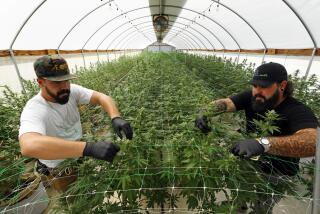Some states allow opioid addicts to try medical marijuana. The federal government isn’t pleased

- Share via
The U.S. government is barring federal dollars meant to treat patients with opioid addiction from being spent on medical marijuana.
The move is aimed at states that allow patients who abuse opioids to try pot instead, said Dr. Elinore McCance-Katz, who leads the federal Substance Abuse and Mental Health Services Administration.
“There’s zero evidence for that,” McCance-Katz said. “We felt that it was time to make it clear we did not want individuals receiving funds for treatment services to be exposed to marijuana and somehow given the impression that it’s a treatment.”
It’s the latest example of the legal standoff between federal and state governments on marijuana. While federal officials consider cannabis an illegal drug, 33 states allow patients to use it for medical purposes with a doctor’s approval. (About a dozen states allow recreational use of marijuana as well.)
The new rule affects billions of dollars that the Substance Abuse and Mental Health Services Administration gives to states for addiction treatment programs. It applies to the federal government’s two main grant programs for opioid treatment and an older grant program that supports state efforts to treat alcoholism and drug addiction.
Federal officials held a phone call with state officials last week to spell out the restriction: Grant money can’t be used to directly or indirectly buy marijuana or permit treatment with pot. The rule also prevents states from using federal dollars to treat mental health disorders with marijuana.
It does not apply to grants from other federal agencies for research on medical marijuana.
Addiction treatment programs that are currently using medical marijuana to treat patients with mental health disorders or addiction must document their efforts to urge those patients to stop. If they don’t, the programs risk losing federal money, McCance-Katz said.
Each state decides which ailments are on their medical marijuana lists. Many allow patients who have a doctor’s approval to use it for chronic pain and symptoms of multiple sclerosis, for which there is good scientific evidence. Other states have approved health conditions with less scientific backing, such as post-traumatic stress disorder or anxiety, swayed by firsthand experience from residents.
The evidence that marijuana helps some patients use fewer opioids comes from anecdotal reports or surveys of drug users, not the type of research that can prove cause and effect. Earlier this year, a study shot down the notion that medical marijuana laws can prevent opioid overdose deaths, challenging a favorite talking point of legal pot advocates.
Yet, the ongoing overdose crisis has caused some states, including New York and New Jersey, to turn to marijuana on the premise that pot “is far less risky than injecting heroin or fentanyl, so why not try it?” said Leo Beletsky, a public health policy expert at Northeastern University in Boston.
In 2018, Pennsylvania became the first state to add opioid use disorder to its medical marijuana list. In announcing the decision, Gov. Tom Wolf also designated eight universities to conduct research on marijuana’s use for that and other medical conditions.
It’s too early to tell if the new federal rule will affect care, said Rachel Kostelac, spokeswoman for Pennsylvania’s Department of Drug and Alcohol Programs. “But we will continue to monitor to ensure individuals are receiving appropriate treatment to combat the opioid epidemic.”






